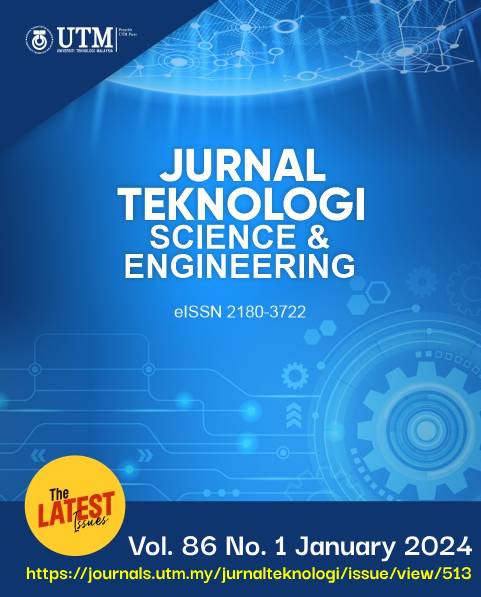A PRELIMINARY STUDY OF AMBIENT ELECTROMAGNETIC RADIATION AT BASE TOWER STATIONS IN RESIDENTIAL AREAS IN KUALA NERUS
DOI:
https://doi.org/10.11113/jurnalteknologi.v86.20331Keywords:
Base Station Tower, Radiofrequency, Electromagnetic Radiation, Public Exposure, Nonionizing Radiation, Residential AreaAbstract
Introduction: Mobile communications developed into an integral component of our daily life. The growing demand for mobile communication services in Kuala Nerus has seen an increase in the installation of base station towers (BST) in residential areas, as well as near schools, and hospitals. Kuala Nerus was selected as a study location because it is a newly developed district in Terengganu, hence, it is crucial to perform electromagnetic radiation (EMR) measurements in the early stages. Objective/aim: This study aimed to measure the RF EMR exposure level in residential areas in Kuala Nerus by measuring the strength of its electric field (EF) strength and power density (PD) value while comparing it with the ICNIRP’s standard guidelines. Materials and methods: Measurements were made using NARDA NBM 550, connected to a probe that could detect frequencies from 100kHz to 6GHz. The data collection period for each point was approximately 6 minutes during daytime. Results: Average radiation levels in terms of EF strength at all locations were found to vary between 0.26 (V/m) to 3.35 (V/m) (PD value about 0.02 µW/cm² to 2.97 µW/cm²). The highest level was measured at Surau Kg Pok Tuyu, which was 5.48% or 18 times lower than the MCMC exposure limit for public areas. Conclusion: The RF value obtained does not exceed the standard limit, which in turn contributes indirectly to health monitoring initiatives for public NIR exposure. This study found that exposure levels in selected BSTs in residential areas in Kuala Nerus were within the standard guideline limits.
References
B. K. Engiz. 2016. Measurement and Assessment of Long Term Electric Field Strength in Different Locations. Int. J. Adv. Res. Comput. Commun. Eng. 5(10): 455-458.
F. B. Elehinafe et al. 2021. Assessment of Environmental Impact of Telecommunication Base Transceivers Stations in Residential Areas. IOP Conf. Ser. Earth Environ. Sci. 655(1).
B. A. Albiss, M. S. Alqudah, and T. S. Odeh. 2015. Environmental Pollution of Cell-Phone Towers: Detection and Analysis Using Geographic Information System. Environ. Pollut. Cell-Phone Towers Detect. Anal. Using Geogr. Inf. Syst. 7(2): 77-85.
S. S. Durduran. 2013. Measurement of Electromagnetic Signal Strengths of Four GSM Base Stations at 900 MHz in a Pilot Region. The World Congress on Engineering 2013. London, U.K. II: 5-8.
F. Ulaby, E. Michielssen, and U. Ravaioli. 2010. Fundamentals of Applied Electromagnetics. Prentice Hall. 528.
K. Singh and A. Nagaraj. 2016. Effect of Electromagnetic Radiations from Mobile Phone Base Stations on General Health and Salivary Function. Journal of International Society of Preventive and Community Dentistry. 6(1): 54-59.
A. Tirkey. 2020. The 5G Dilemma: Mapping Responses Across the World. Observer Research Foundation.
N. A. Badaluddin et al. 2020. Isolation and Characterization of High Ambient Electromagnetic Radiation (EMR) Bacteria. Malaysian Appl. Biol. 49(4): 165-172.
M. Hadi and P. Sultan. 2012. Public Safety Assessment of Electromagnetic Radiation Exposure from Mobile Base Stations. April 2016.
I. Eustatiu and C. Poparlan. 2016. Assessment of GSM HF-Radiation Impact Levels within the Residential Area of Craiova City. Procedia Environ. Sci. 32: 177-183.
L. Seyfi. 2017. Determination of Electromagnetic Radiation Levels at Two Primary Schools near Base Stations. 5(1): 49-53.
ICNIRP. 2020. Guidelines for Limiting Exposure to Electromagnetic Fields (100 kHz to 300 GHz). 118(5).
A. Singh, A. Jyoti, and R. S. Tomar. 2020. Mobile Phone Radiations as an Alarming Tool for Human Health : A Review Mobile Phone Radiations as an Alarming Tool for Human Health: A Review. Sustainable Technology and Entrepreneurship. 2(2).
J. Bidhan et al. 2023.) Effects of Electromagnetic Radiation Emittted by Smartphones on Sperm Quality: An in Vitro Study. J. Sex. Med. 20(Supplement_1): qdad060.173.
BERNAMA. 2020. 66 Menara Telekomunikasi Baharu di Terengganu.
G. Vermeeren, I. Markakis, F. Goeminne, T. Samaras, L. Martens, and W. Joseph. 2013. Spatial and Temporal RF Electromagnetic Field Exposure of Children and Adults in Indoor Micro Environments in Belgium and Greece. Prog. Biophys. Mol. Biol. 113(2): 254-263.
ICNIRP. 2009. Guidelines for Limiting Exposure to Time-varying Electric, Magnetic, and Electromagnetic Fields (up to 300 GHz). Int. Comm. Non-Ionizing Radiat. Prot. (ICNIRP). ICNIRP Statement.
I. A. Rahman et al. 2012. Policy Development, Monitoring and Subject Reintroduction of Nonionising Radiation in Universiti Kebangsaan Malaysia. Procedia - Soc. Behav. Sci. 59: 657-662.
D. Gürğan and L. Seyfi. 2018. Determination and Analysis of Electromagnetic Pollution at Two Shopping Malls in Konya at 100 kHz-3 GHz Frequency. Int. J. Environ. Sci. Dev. 9(9): 266-269.
A. R. S. N. Dianah, R. Umar, M. K. A. Kamarudin, A. N. Dagang, and S. N. Hazmin. 2018. Exposure Level from Selected Base Station Tower around Kuala Nerus: A Preliminary Analysis. J. Fundam. Appl. Sci. 9(5S): 367.
C. Kurnaz, D. Yildiz, and S. Karagol. 2018. Assessment of Short/long term Electric Field Strength Measurements for a Pilot District. Open Phys. 16(1): 69-74.
H. N. Syafiqah et al. 2018. Non-ionizing Radiation: Exposure Level at UMT and UniSZA Campus. ASM Sci. J. 11(Special Issue 1: 183-194.
R. A. Michaels. 2019. Telecommunications, Electromagnetic Fields, And Human Health. Environ. Claims J. 31(2): 93-132.
O. S. Aboyeji and J. O. Ojo. 2016. Assessment of Exposure to Electromagnetic Radiation from GSM Antennas within and Around Two Health Facilities at the Obafemi Awolowo University, Ile-Ife, Nigeria. Ife J. Sci. 18(4): 1053-1063–1063.
T. Koppel, M. Ahonen, M. Carlberg, and L. Hardell. 2022. Very High Radiofrequency Radiation at Skeppsbron in Stockholm, Sweden from Mobile Phone Base Station Antennas Positioned Close to Pedestrians’ Heads. Environ. Res. 208(January): 112627.
S. N. Hazmin, A. R. S. N. Dianah, M. K. A. Kamarudin, R. Umar, and H. N. Syafiqah. 2018. Non-Ionizing Radiation (NIR) Exposure Map Development Using GIS for Gong Badak, Terengganu, Malaysia. MATEC Web Conf. 248(April 2011): 1-5.
.
Downloads
Published
Issue
Section
License
Copyright of articles that appear in Jurnal Teknologi belongs exclusively to Penerbit Universiti Teknologi Malaysia (Penerbit UTM Press). This copyright covers the rights to reproduce the article, including reprints, electronic reproductions, or any other reproductions of similar nature.
















